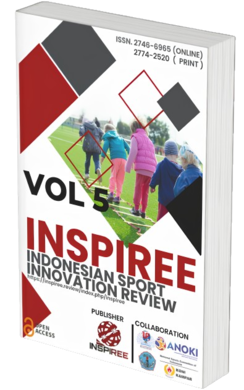Physical Fitness and Learning Achievement Academic in Children Aged 10-12 years
DOI:
https://doi.org/10.53905/inspiree.v2i2.51Keywords:
Student Achievement, Physical FitnessAbstract
The purpose of the study. The purpose of this study was to determine how big the impact of physical fitness on student achievement
Materials and methods. The method in this research is a path analysis method with a correlational test technique. Correlational refers to taking the rsquare hypothesis, which is how big the impact of the correlation between physical fitness and student learning achievement is and this study uses the SPSS Version 25 application.
Results.The results found that the level of the variable physical fitness on learning achievement with r = 0.708 with rsquare = 0.501 Coefficients sig value . 0.000. It turns out that the value of sig. 0.000 is less than the probability value of 0.00 or the value of 0.05>0.000.
Conclusions. Then Ha is accepted and H0 is rejected, meaning that the path analysis coefficient is significant. This study proves that there is a direct impact of physical fitness on student achievement.
References
Alvarez-Bueno, C., Pesce, C., Cavero-Redondo, I., Sanchez-Lopez, M., Garrido-Miguel, M., & Martinez-Vizcaino, V. (2017). Academic achievement and physical activity: A meta-analysis. Pediatrics, 140(6). https://doi.org/10.1542/peds.2017-1498 DOI: https://doi.org/10.1542/peds.2017-1498
Apriyano, B., Zainuddin, Z. A., & Hashim, A. H. M. (2020). Physical Fitness of Student at the Junior High School. 460(Icpe 2019), 105–110. https://doi.org/10.2991/assehr.k.200805.030 DOI: https://doi.org/10.2991/assehr.k.200805.030
Beauchamp, M. R., Crawford, K. L., & Jackson, B. (2019). Social cognitive theory and physical activity: Mechanisms of behavior change, critique, and legacy. Psychology of Sport and Exercise, 42(November), 110–117. https://doi.org/10.1016/j.psychsport.2018.11.009 DOI: https://doi.org/10.1016/j.psychsport.2018.11.009
Eveland-sayers, B. M., Farley, R. S., Fuller, D. K., Morgan, D. W., & Caputo, J. L. (2009). Physical Fitness and Academic Achievement in Elementary School Children. Journal of Physical Activity and Health, 6, 99–104. http://community.lhup.edu/beverhar/Fitness and Academic Achievement in Elementary Students_Everand-Sayers, Farley et al. 2009.pdf DOI: https://doi.org/10.1123/jpah.6.1.99
Fosnot, C. T., & Perry, R. S. (1996). Constructivism: A Psychological Theory of Learning. Constructivism: Theory, Perspectives, and Practices, 0, 28. http://rsperry.com/fosnotandperry.pdf
Golubović, Š., Maksimović, J., Golubović, B., & Glumbić, N. (2012). Effects of exercise on physical fitness in children with intellectual disability. Research in Developmental Disabilities, 33(2), 608–614. https://doi.org/10.1016/j.ridd.2011.11.003 DOI: https://doi.org/10.1016/j.ridd.2011.11.003
Gonzalez, C., Best, B., Healy, A. F., Kole, J. A., & Bourne, L. E. (2011). A cognitive modeling account of simultaneous learning and fatigue effects. Cognitive Systems Research, 12(1), 19–32. https://doi.org/10.1016/j.cogsys.2010.06.004 DOI: https://doi.org/10.1016/j.cogsys.2010.06.004
Grissom, J. B. (2005). Physical Fitness And Academic Achievement. Journal of Exercise Physiology, 8(1), 11–25. https://peacefulplaygrounds.com/pdf/right-to-recess/fitness-academic-achievement.pdf
Kriswanto, E. S., Setijono, H., & Mintarto, E. (2019). The effect of cardiorespiratory fitness and fatigue level on learning ability of movement coordination. Cakrawala Pendidikan, 38(2), 320–329. https://doi.org/10.21831/cp.v38i2.24565 DOI: https://doi.org/10.21831/cp.v38i2.24565
London, R. A., & Castrechini, S. (2011). A longitudinal examination of the link between youth physical fitness and academic achievement. Journal of School Health, 81(7), 400–408. https://doi.org/10.1111/j.1746-1561.2011.00608.x DOI: https://doi.org/10.1111/j.1746-1561.2011.00608.x
Marques, A., Santos, D. A., Hillman, C. H., & Sardinha, L. B. (2018). How does academic achievement relate to cardiorespiratory fitness, self-reported physical activity and objectively reported physical activity: A systematic review in children and adolescents aged 6-18 years. British Journal of Sports Medicine, 52(16), 1039. https://doi.org/10.1136/bjsports-2016-097361 DOI: https://doi.org/10.1136/bjsports-2016-097361
Masciotra, D., Roth, W.-M., & Morel, D. (2019). Enactive Education. Enaction, 151–154. https://doi.org/10.1163/9789087901004_010 DOI: https://doi.org/10.1163/9789087901004_010
Ogunleye, B. O., & Ojo, O. R. (2019). Impact of physical fitness activities on students’ Basic Science achievement in selected Nigerian secondary schools. Annual Journal of Technical University of Varna, Bulgaria, 3(2), 21–31. https://doi.org/10.29114/ajtuv.vol3.iss2.145 DOI: https://doi.org/10.29114/ajtuv.vol3.iss2.145
Schleicher, R., Galley, N., Briest, S., & Galley, L. (2008). Blinks and saccades as indicators of fatigue in sleepiness warnings: Looking tired? Ergonomics, 51(7), 982–1010. https://doi.org/10.1080/00140130701817062 DOI: https://doi.org/10.1080/00140130701817062
Downloads
Published
How to Cite
Issue
Section
License
Copyright (c) 2021 Herli Pardilla

This work is licensed under a Creative Commons Attribution-ShareAlike 4.0 International License.


















